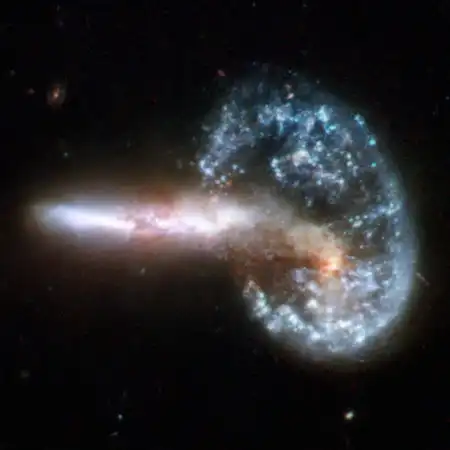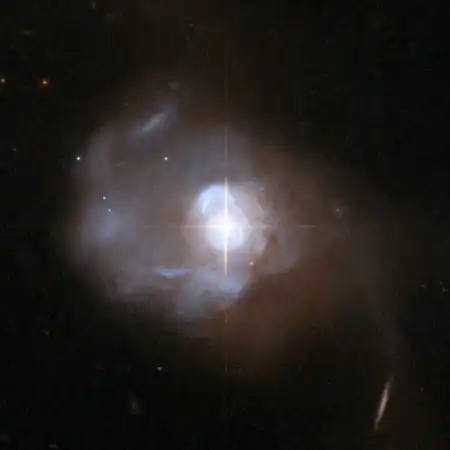Столкновение галактик
NASA has released 59 new high-resolution images of galaxies colliding across the universe to mark the Hubble Space Telescope's 18th birthday.
Many of the galaxies were first compiled by Halton Arp in the mid-'60s book, The Atlas of Peculiar Galaxies, which cataloged misshapen galaxies glimpsed by the ground-based telescopes of the day.
With the Hubble's sensitive cameras and tools, the shapes of these peculiar galaxies have been revealed as the product of gravitational interactions between the huge clusters of stars. As gravity pulls the galaxies together, the tidal forces at work warp the standard galactic spirals and ellipses into temporarily strange shapes.
Left: Arp 148 consists of a ring-shaped galaxy and a long-tailed companion. The ring was created by a shockwave that resulted from the galaxies colliding. Located in the Ursa Major constellation about 500 million light-years away, Arp 148 is thought to provide a unique snapshot of an ongoing collision.
Photo: NASA, ESA, the Hubble Heritage Team (STScI/AURA)-ESA/Hubble Collaboration and A. Evans (University of Virginia, Charlottesville/NRAO/Stony Brook University), K. Noll (STScI), and J. Westphal (Caltech)
Arp 256 consists of two spiral galaxies in an early stage of merging. The gravitational force between the two galleries has pulled ribbons of gas out of each galaxy and toward the other as they inexorably grow closer. The luminous infrared system is radiating at more than 100 billion times the luminosity of our sun. Arp 256 is located about 350 million light-years away in the constellation of Cetus, the Whale.
Photo: NASA, ESA, the Hubble Heritage Team (STScI/AURA)-ESA/Hubble Collaboration and A. Evans (University of Virginia, Charlottesville/NRAO/Stony Brook University)
NGC 6240 is a butterfly-shaped galaxy composed of two smaller merging galaxies. Within the system, two giant black holes, about 3,000 light-years apart, are drifting toward each other until, in some tens of millions of years, they will unite to form one massive singularity. NGC 6240 lies in the constellation of Ophiuchus, the Serpent Holder, about 400 million light-years away.
Photo: NASA, ESA, the Hubble Heritage Team (STScI/AURA)-ESA/Hubble Collaboration and A. Evans (University of Virginia, Charlottesville/NRAO/Stony Brook University)
UGC 8335 is a strongly interacting pair of spiral galaxies. A bridge of gas and dust now connects the two galactic cores, and both exhibit curved tails. UGC 8335 is located in the constellation of Ursa Major, the Great Bear, about 400 million light-years from Earth.
Photo: NASA, ESA, the Hubble Heritage Team (STScI/AURA)-ESA/Hubble Collaboration and A. Evans (University of Virginia, Charlottesville/NRAO/Stony Brook University)
This image shows two galaxies, LEDA 62867 and NGC 6786, beginning to fall into each other's gravitational field. NGC 6787, right, will eventually swallow its smaller neighbor. The galaxies are located in the constellation of Draco, the Dragon, about 350 million light-years away.
Photo: NASA, ESA, the Hubble Heritage Team (STScI/AURA)-ESA/Hubble Collaboration and A. Evans (University of Virginia, Charlottesville/NRAO/Stony Brook University)
Arp 272 is a collision between two spiral galaxies, NGC 6050 and IC 1179, that are linked by their swirling arms. They are part of the Hercules Galaxy Cluster, which itself is part of one of the largest known structures in the universe: the so-called Great Wall. Arp 272 is located some 450 million light-years away from Earth.
Photo: NASA, ESA, the Hubble Heritage Team (STScI/AURA)-ESA/Hubble Collaboration and K. Noll (STScI)
Arp 240 is a pair of similar-size spiral galaxies, NGC 5257 and NGC 5258. The galaxies are visibly interacting with each other via a bridge of dim stars. Both galaxies harbor supermassive black holes in their centers. Arp 240 is located in the constellation Virgo, approximately 300 million light-years away. (With the exception of a few foreground stars from our own Milky Way all the objects in this image are galaxies.)
Photo: NASA, ESA, the Hubble Heritage Team (STScI/AURA)-ESA/Hubble Collaboration and A. Evans (University of Virginia, Charlottesville/NRAO/Stony Brook University)
ESO 99-4 is a galaxy with an unusual shape that is probably the remnant of an earlier merger process that has deformed it. ESO 99-4 lies in the constellation of Triangulum Australe, the Southern Triangle, about 400 million light-years away.
Photo: NASA, ESA, the Hubble Heritage Team (STScI/AURA)-ESA/Hubble Collaboration and A. Evans (University of Virginia, Charlottesville/NRAO/Stony Brook University)
The extraordinary galaxy Markarian 231 was discovered in 1969 as part of a survey searching for galaxies with strong ultraviolet radiation. The galaxy has a powerful quasar at its center, long tidal tails and a disturbed shape. Long considered a unique space object, it's one of the most luminous and powerful infrared galaxies, with astronomical evidence suggesting that a black hole at its center drives its enormous luminosity. UGC 8058 is located about 600 million light-years away from Earth.
Photo: NASA, ESA, the Hubble Heritage Team (STScI/AURA)-ESA/Hubble Collaboration and A. Evans (University of Virginia, Charlottesville/NRAO/Stony Brook University)
This is a system of merging galaxies with a bizarre shape. Young starburst regions hang between the main galaxy cores. Zw II 96 is located in the constellation of Delphinus, the Dolphin, about 500 million light-years away from Earth.
Photo: NASA, ESA, the Hubble Heritage Team (STScI/AURA)-ESA/Hubble Collaboration and A. Evans (University of Virginia, Charlottesville/NRAO/Stony Brook University)
This beautiful pair of interacting galaxies consists of NGC 5754, the large spiral on the top and NGC 5752, its smaller companion. NGC 5754's internal structure is almost entirely intact, while NGC 5752 has undergone a starburst episode, with a rich population of massive and luminous star clusters clumping around the core and intertwined with intricate dust lanes. NGC 5754 is located in the constellation Boötes, the Herdsman, some 200 million light-years away.
Photo: NASA, ESA, the Hubble Heritage Team (STScI/AURA)-ESA/Hubble Collaboration and W. Keel (University of Alabama, Tuscaloosa)
AM0500-620 consists of a spiral galaxy seen nearly face-on and partially backlit by a smaller galaxy. Previously classified as an elliptical galaxy, Hubble has revealed the background galaxy's spiral shape, with its dusty arms clustered around bright knots of stars. AM0500-620 is 350 million light-years away from Earth in the constellation of Dorado, the Swordfish.
Photo: NASA, ESA, the Hubble Heritage Team (STScI/AURA)-ESA/Hubble Collaboration and W. Keel (University of Alabama, Tuscaloosa)











